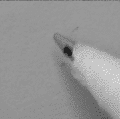 |
PDF download |  |
Summary
field-tested engineer specialized in machine learning, applied statistics, and numerical modeling
Education
Tufts University School of Engineering
- PhD in Environmental and Water Resources Engineering (2023)
- MS in Civil and Environmental Engineering (2018)
- BS in Environmental Engineering, Chinese Minor (2011)
Expertise
- Python for analysis, automation, modeling, and optimization
- parameter estimation and uncertainty quantification for ill-posed inverse problems
- machine learning and statistical inference
- high-performance distributed computing
- stochastic modeling
- Markov chain Monte Carlo methods
- computer vision
- numerical integration of ODEs
- proficient Mandarin Chinese (HSK Level 6)
Honors
- Licensed Site Professional Association Scholarship
- BSCES Jonathan B. Golden Scholarship
Activities
www.megamandarin.com; 2020–present; founder
- online business selling tools for increasing Chinese vocabulary and learning calligraphy
- raised nearly $2k for UNICEF
Medford Chess Club; 2018–present; primary organizer
- arrange weekly chess meetup in Medford, MA
- spearheaded giant chess set installation in Riverside Plaza
Work Experience
Tufts University Integrated Multiphase Environmental Systems Laboratory Medford, MA 2016–2023; graduate research assistant
- Published three papers, with one more currently in peer review.
- Created numerical models to simulate bioremediation of chlorinated solvents by bioaugmentation cultures.
- Conducted large-scale Monte Carlo experiments to evaluate best practices for estimating microbial model parameters from lab data.
- Investigated inhibition of chlorinated solvent bioremediation by PFAS contamination.
- Refined machine learning models for interpolating between soil boring data.
Suntime Environmental Remediation Company; Changzhou, Jiangsu Province, China; 2014–2015; assistant project manager
- Oversaw work at several environmental remediation projects involving heavy metal, organic, and other contamination.
- Managed health and safety program for an office of approximately 40 technical staff.
- Translated technical reference materials and company publications to and from Chinese.
- Assisted with business development and client relations.
Roux Associates; Woburn, MA; 2011–2014; staff engineer, staff assistant engineer, intern
- Worked on site at dozens of different environmental remediation projects involving organic, caustic, radioactive, and other contamination.
- Responsible for coordinating field events and training entry-level staff.
- Managed equipment procurement, storage, and maintenance for an office of approximately 30 technical staff.
- Oversaw and assisted with remediation system pilot tests.
- Wrote reports for client and government review.
Selected Coursework (chronological)
- Differential Equations
- Environmental Engineering Principles
- Technical Writing
- Probability and Statistics
- Environmental Geology
- Environmental Chemistry
- Physical Chemistry
- Groundwater
- Environmental Engineering Processes
- Groundwater Chemistry and Quality
- Hydrology
- Fluid Mechanics
- Numerical Methods
- Introduction to Hydraulic Engineering
- Environmental and Water Resource Systems Optimization
- Computational Methods in Environmental Water Resources
- Groundwater Modeling
- Chemical Principles in Environmental and Water Resources Engineering
- Transport Principles in Environmental and Water Resources Engineering
- Reactive Transport in Porous Media
- Introduction to GIS
- Numerical Linear Algebra
- Environmental Statistics
- Introduction to Machine Learning and Data Mining
Teaching Experience
Hydrogeology Field Methods Class 2014–2022; paid instructor
- Gave annual demonstration of groundwater sampling as per EPA low-flow methodology.
- Used consulting industry experience to introduce students to practicalities of environmental remediation fieldwork.
- Procured and maintained equipment.
Computer Aided Design Class 2018; teaching assistant
- Helped teach students to use AutoCAD and SolidWorks during weekly lab sessions.
- Graded assignments.
Research Experience and Publications
Subsurface Source Zone Characterization and Uncertainty Quantification Using Discriminative Random Fields (link)
- Assisted paper authors by debugging code and running subsurface multiphase contaminant transport models to generate synthetic training data.
- A machine learning model was trained to use soil boring data for predictions of where denser-than-water contaminants had pooled in the subsurface.
- Wrote dissertation proposal to expand the model's prediction capability from 2D to 3D, but proposal failed to get funding because research priorities were transitioning to PFAS.
Exploration of Processes Governing Microbial Reductive Dechlorination in a Heterogeneous Aquifer Flow Cell (link)
- Wrote numerical model describing the microbially mediated degradation of contaminants in laboratory treatability tests.
- Estimated kinetic parameters of degradation process by fitting model to experimental data.
Microbial Reductive Dechlorination by a Commercially Available Dechlorinating Consortium Is Not Inhibited by Perfluoroalkyl Acids at Field-Relevant Concentrations (link)
- Fit microbial model to laboratory experiments designed to measure how the presence of PFAS can slow the degradation of other subsurface contaminants.
- Used a superposition of an analytical solution to the diffusion equation to refine predictions of experimental mass loss.
- Extremely ill-posed nature of inverse problem resulted in large computing resource requirements for model-fitting optimization, so I used a free trial of Google Cloud to quickly complete the parameter estimation process.
Quantifying Impacts of Microcosm Mass Loss on Kinetic Constant Estimation (link) first author
- Summarized 20+ studies of microbially mediated contaminant degradation to illustrate how incidental mass loss of contaminants from laboratory equipment was common but also routinely excluded from the numerical models used to estimate parameters.
- Used WebPlotDigitizer to extract plotted concentration measurements from studies that did not share mass loss estimates.
- Conducted Monte Carlo experiment to demonstrate that excluding mass loss from the numerical model frequently resulted in biased kinetic parameter estimates.
- Shared results via poster and flash presentation at 2021 RemTEC Summit.
On the Reliable Estimation of Sequential Monod Kinetic Parameters (link) first author
- Used Hamiltonian Monte Carlo to randomly select sets of microbial degradation kinetic parameters that result in realistic synthetic datasets.
- Performed Monte Carlo experiment with more than a million individual model fittings to measure accuracy and precision of parameter estimates derived from different types of laboratory treatability test designs.
- Implemented likelihood-ratio test to show that a commonly used treatability test design will usually result in failure to uniquely estimate subsets of the kinetic parameters.
- Demonstrated that ill-posed nature of inverse problem can be largely attributed to extreme collinearity of model fitting results.
- Compared nonlinear regression analysis and Markov chain Monte Carlo to determine which method results in more reliable interval estimates of kinetic parameters.
- Computational resources required for the various Monte Carlo experiments greatly exceeded what could feasibly be performed on the Tufts HPC cluster with my user privileges, so I adapted the code to run on a disused computer cluster originally purchased by the Geology Department in 2009.
References
Four professional references are available upon request.